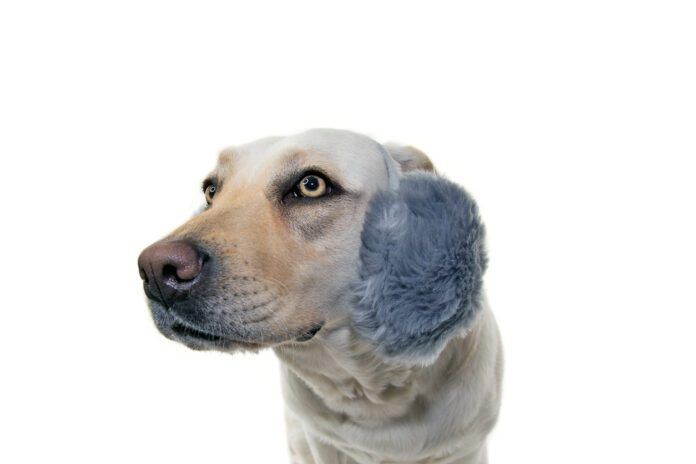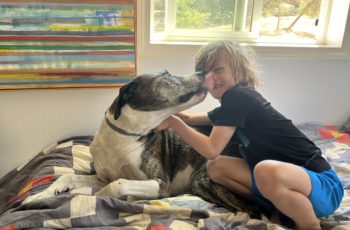
Photo credit: smrm1977 | Getty Images
Hearing protection for your dog? Of course! We want our dogs to live their best lives, so we dwell on their diet, their vaccinations, their teeth, their vision . . . and we should think about hearing, too. Hearing loss can happen due to constant exposure to loud noise, just as it can with humans. Ear muffs for dogs can also provide comfort to noise-sensitive dogs, like the ones who can’t handle a thunderstorm, fireworks, the vacuum, or a barrage of sirens in the area. A 2021 study in Frontiers in Veterinary Science found that sudden loud noises are the most common trigger for fearful behavior in dogs. Clearly, these dogs need our help.
Noise-induced hearing loss happens when the delicate structures of a dog’s middle and inner ear are harmed by loud noises. In medical terms, “The stereocilia are specialized hair cells in the dog’s cochlea that vibrate in response to sound waves, which can get damaged from loud noises,” says Paola Cuevas, a veterinarian, MVZ, and behaviorist. Once damaged, these sensory cells are unable to send signals to the dog’s brain, resulting in hearing loss. “The eardrum or tympanic membrane as well as the inner ear’s ossicles can also get damaged with extreme and repeated percussion noise.”
In addition to concerns about hearing loss are the dogs who are afraid of loud noises. These dogs find holidays like the Fourth of July almost unbearable. “Noise sensitivity is a very common cause of anxiety in dogs. It can present signs such as pacing, shaking, hiding, and sometimes getting lost or even destructive behavior,” says Dr Cuevas. For additional information on noise-induced anxiety in your dog, consider enrolling in our online course “Dogs and Noise Anxiety.” A noise-muffling ear muff can go a long ways toward helping these dogs.
Recognizing the need for hearing protection and muffling loud noises for dogs, several manufacturers developed a range of ear muffs specifically designed for dogs. These products are typically made from soft, comfortable materials and feature adjustable straps to ensure a secure fit. In 2013, a study published in Radiology looked at Mutt Muffs to block the sound of an MRI (if you ever had one, you know how noisy they are!) and found that Mutt Muffs helped block the noise and prevented repeat scans caused by the dog not holding still.
Dog ear muffs operate on a similar principle to human ear protection. They create a barrier between the dog’s ears and the external noise, reducing the sound intensity that reaches the inner ear. While they may not eliminate all noise, they can significantly dampen loud sounds, providing relief and protection for your pet. “It is worth checking out the military-grade products such as Canine Auditory Protection System (CAPS), new military-designed approach to hearing protection that combines effective noise reduction with comfort and the ability to maintain communication,” says Dr. Cuevas. “Repeated exposure to loud noises not only contributes to anxiety but also can result in progressive hearing loss.”
There’s no shortage of products to choose from both online and in pet stores. Below is a sampling of some of the leading ear-protection products available.
Whole Dog Journal is reader-supported. If you purchase through links on our site we may earn a commission. Whole Dog Journal does not accept money for its food and product reviews.
Mutt Muffs
- Key Features: Soft, comfortable materials, adjustable straps, high noise reduction rating, variety of colors and sizes.
- Price: $60 to $80.
Rex Specs Ear Pro
- Key Features: Durable construction, high noise reduction rating, adjustable straps, available in multiple colors.
- Price: $70 to $100.
PuroPup
- Key Features: Stylish design, comfortable fit, adjustable straps, high noise reduction rating.
- Price: $40 to $60.
Woofworks
- Key Features: Lightweight, breathable materials, adjustable straps, effective noise reduction.
- Price: $30 to $50.
DerYEP
- Key Features: Affordable option, decent noise reduction, adjustable straps.
- Price: $30-$50.
Custom-Molded Earplugs
For dogs with unique ear shapes or sensitivities, custom-molded earplugs can provide a more personalized and comfortable fit. Ask your veterinarian about how to get these made for your dog. And, in general, consult with your veterinarian to determine the best ear protection option for your pet.
While we lean toward Mutt Muffs as our first pick, your choice in a dog ear muff to help protect your dog’s hearing and/or muffle scary noises depends widely on your individual dog. Fit is everything (think about your own ear mufflers for mowing the lawn—if they drive you crazy, you won’t wear them). Read the manufacturer’s description, note the measurements of the device compared to your dog’s size, the product adjustability, and the manufacturer’s advice on fit. If needed, call the company’s customer service. You can also get your veterinarian’s advice, as he or she may have experience with various devices.
Hearing Aids
For dogs who have already suffered hearing loss, a hearing aid might help, but it must be custom fit for each dog to the tune of $3,000 or more. The FETCHLab at the University of Cincinnati makes hearing aids made for dogs. Your dog will need to be trained to wear the hearing aid. Note: Hearing aids won’t work for dogs who have lost all hearing. Hearing aids work by amplifying sound, but if your dog has congenital deafness there is no residual hearing left to amplify. Another method to consider for a deaf dog is a vibration collar. Read more in “Do They Make Hearing Aids for Dogs.”
Canines have a much wider hearing range than humans and can hear in an approximate range of 67,000 herz (Hz) to 65,000 Hz, while we can detect only up to 23,000 Hz. Dogs can hear things we can’t, and they can pinpoint the precise location of sounds.
This impressive sense of hearing comes a price. Cuevas says dog ears can easily be damaged at noise levels above 85 decibels, which is easily exceeded by everyday household noises such as a vacuum or even a screaming child. Attenuating noises with ear protection can make the difference between suffering irreparable damage leading to hearing loss and even deafness, which leaves them even more exposed to other dangers in the environment. However, noise-induced hearing loss in dogs is preventable with hearing protection.
Dogs who spend time in an environment with loud percussion noises definitively need ear protection or ear muffs. “Police dogs, service dogs, military dogs, search and rescue dogs, and dogs guarding construction sites are all very susceptible to suffering from noise-induced hearing loss and will need to have some ear protection,” says Cuevas.
Beyond the dogs trained for specific functions, any dog can experience hearing loss due to prolonged exposure to loud noises common in everyday life—from the bang of fireworks to the roar of a jet engine—can have an impact.
Given how much more acute dogs hearing is compared to ours, their sensitive ears can be overwhelmed. While any loud noise can potentially cause damage, be especially cautious in these scenarios:
- Air travel: The noise levels in airplane cabins can be harmful to a dog’s hearing.
- Outdoor events: Concerts, sporting events, and other loud gatherings can be overwhelming for dogs.
- Construction sites: Exposure to heavy machinery and construction noise can damage a dog’s hearing.
How do you know if your dog may be experiencing hearing loss? Kari Foss, a veterinary neurologist and professor of veterinary clinical medicine at the University of Illinois at Urbana-Champaign, lists these warning signs:
- Failing to respond when called
- Sleeping through sounds that normally would rouse them.
- Startling at loud noises that previously didn’t bother them.
- Barking excessively or making unusual vocal sounds.
Foss added that dogs with deafness in one ear might respond to commands but could have difficulty locating the source of a sound.


